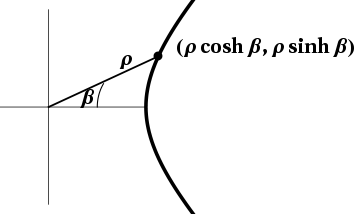Chapter 1: Introduction
- §1. Line Elements
- §2. Circle Trig
- §3. Hyperbola Trig
- §4. Geometry of SR
- §5. Differential Forms
- §6. Geodesics
- §7. The Physics of GR
Hyperbola Trig
 Figure 1: Defining the hyperbolic trigonometric functions via a (Lorentzian)
hyperbola.
Figure 1: Defining the hyperbolic trigonometric functions via a (Lorentzian)
hyperbola.
We now apply the same procedure to Lorentzian hyperbolas rather than Euclidean circles, as illustrated in Figure 1.
- Draw a hyperbola of “radius” $\rho$, that is, the set of points at constant (squared) distance $r^2=x^2-t^2$ from the origin.
- Measure arclength $\tau$ along the hyperbola by integrating the (absolute value of the square root of the) line element. That is, integrate $d\tau$, where $d\tau^2=-ds^2=dt^2-dx^2$.
- Define angle measure as $\beta=\tau/\rho$.
- Assuming an angle in standard position (counterclockwise from the positive $x$-axis), define the coordinates of the (other) point where the sides of the angle meet the given hyperbola to be $(\rho\cosh\beta,\rho\sinh\beta)$.
Again, notice the key role that arclength plays in this construction. 1)
See Hyperbola Geometry for further details.
1)
And again, this is not as easy as it sounds. It is straightforward to use
$x^2-t^2=\rho^2$ to obtain $x\,dx-t\,dt=0$, so that $d\tau^2=\rho^2\,dt^2/x^2$.
But it is not obvious how to integrate $d\tau$ without using a (hyperbolic) trig
substitution! Again, some algebra helps, since
\[
d\beta
= \frac{1}{\rho} \> d\tau
= \frac{dt}{x} \, \frac{1+\frac{t}{x}}{1+\frac{t}{x}}
= \frac{d(x+t)}{x+t}
\]
so that
\[
\rho \, e^{\beta} = x + t
\]
from which the hyperbolic trig functions can be expressed as usual in terms of
the exponential function, and arclength in terms of the logarithm function.